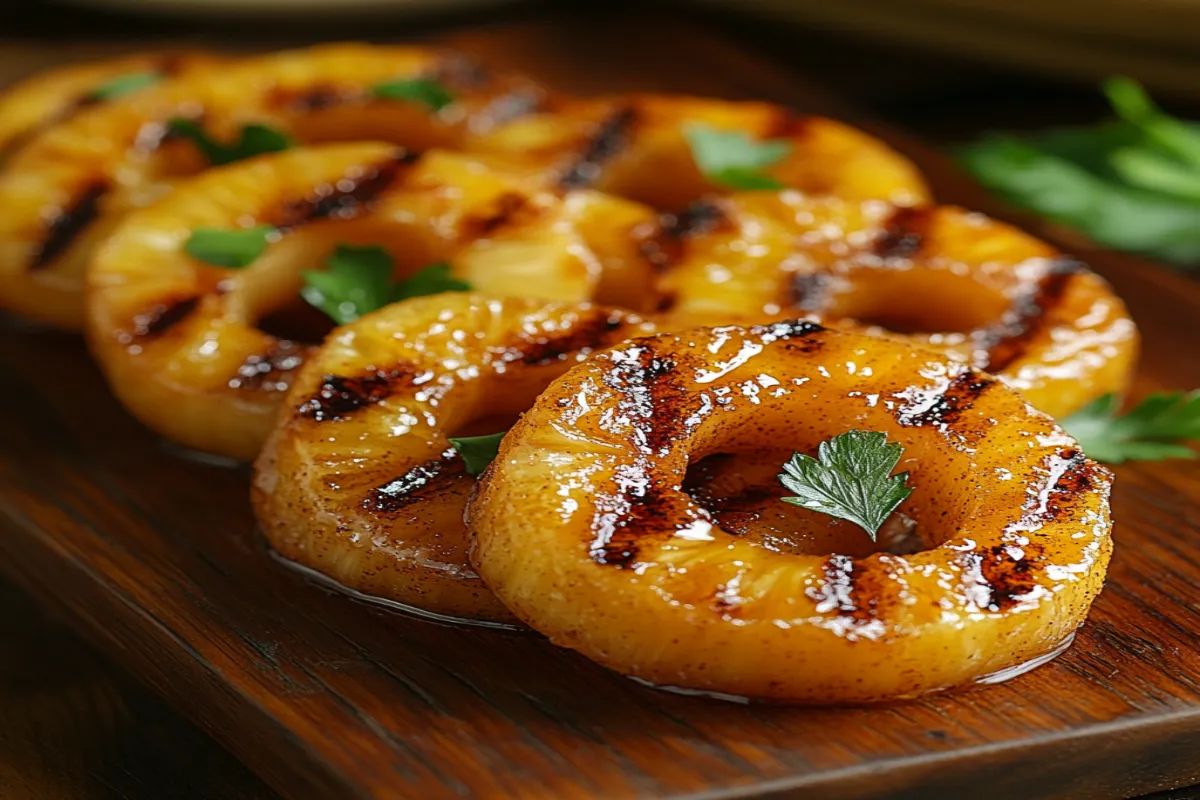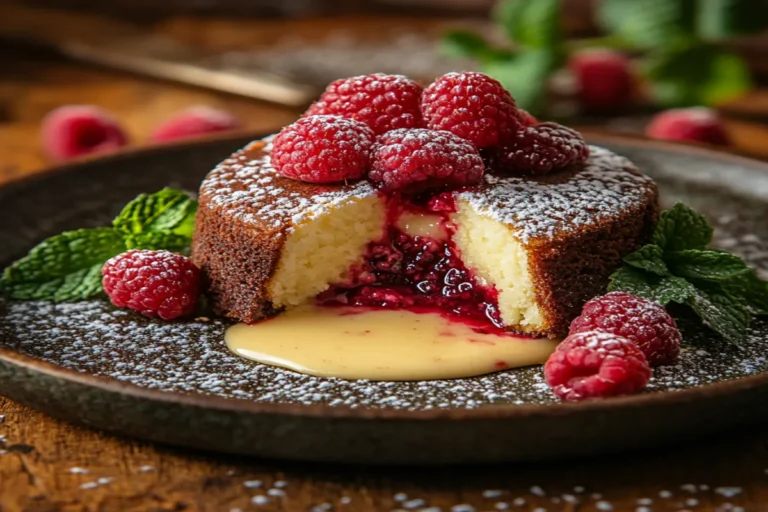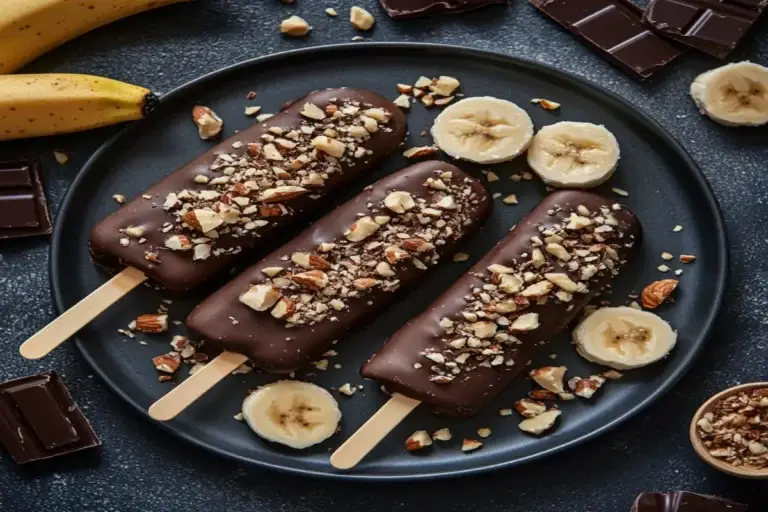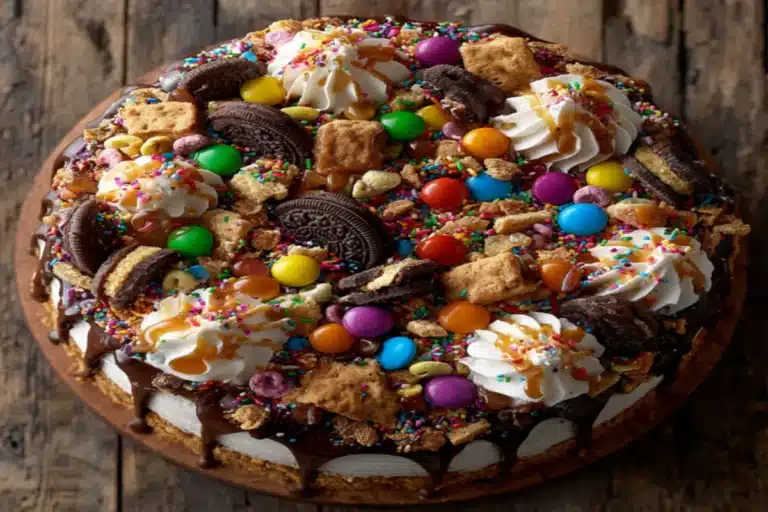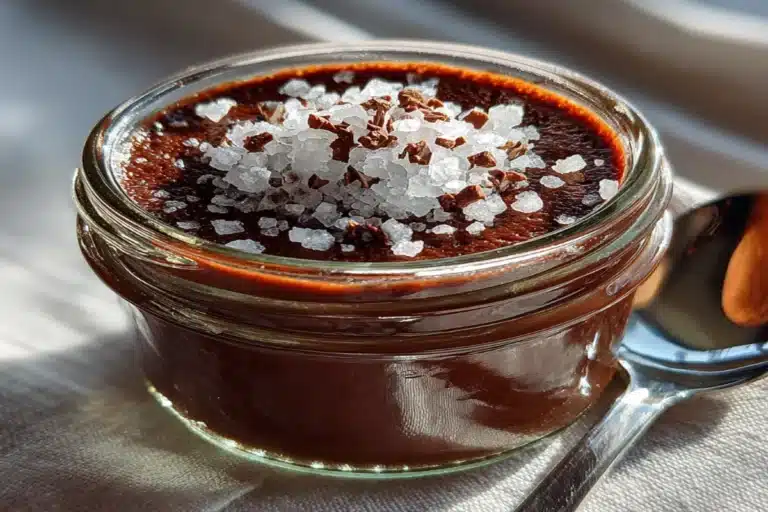Grilled Pineapple with Cinnamon Sugar Glaze – Irresistible Dessert
When summer evenings call for something sweet yet refreshing, few desserts can rival the simple elegance of grilled pineapple. This culinary transformation takes an already delightful tropical fruit and elevates it to extraordinary heights—caramelizing natural sugars, intensifying flavors, and creating a dessert experience that feels simultaneously indulgent and wholesome.
My love affair with grilled pineapple began during a beachside dinner in Hawaii, where a local chef served thick slices kissed by flame and drizzled with a cinnamon-infused glaze that perfectly balanced the fruit’s natural acidity. That first bite—smoky, sweet, and impossibly juicy—became a flavor memory I’ve spent years recreating and perfecting in my own backyard. Now, it’s the dessert I’m most frequently asked to bring to summer gatherings, earning devotees with each serving.
What makes this dessert particularly appealing is its beautiful simplicity. The cinnamon sugar glaze requires just a handful of pantry staples but creates a complex flavor profile that transforms humble pineapple into a dessert worthy of the finest restaurants. With minimal effort and maximum impact, grilled pineapple with cinnamon sugar glaze represents the perfect balance of impressive and accessible—a combination that makes any cook look like a culinary genius.
Table of Contents
The Appeal of Grilled Desserts
The magic of applying flame to fruit creates a culinary alchemy that transforms the ordinary into the extraordinary. When heat meets the natural sugars in fruits like pineapple, a beautiful caramelization occurs—converting simple sugars into complex flavor compounds that offer depth and richness impossible to achieve through other cooking methods.
This flavor transformation is particularly dramatic with pineapple. The fruit’s natural sugars concentrate under heat, while the acids mellow significantly, creating a more balanced, complex sweetness. Meanwhile, the grilling process introduces subtle smoky notes that create a sophisticated counterpoint to the fruit’s tropical brightness. This interplay of sweet, tangy, and smoky creates a multi-dimensional flavor experience that keeps your palate engaged with each bite.
Texturally, grilled pineapple offers the perfect contrast between a slightly firm, caramelized exterior and a tender, juicy interior. This textural journey—from the slight resistance of the grill-marked surface to the succulent center—creates a sensory experience that far exceeds the sum of its parts.
Perhaps the most beautiful aspect of grilled desserts is their chameleon-like versatility. The same preparation can feel perfectly appropriate at both casual backyard barbecues and elegant dinner parties. Serve a slice alongside a scoop of vanilla ice cream for a relaxed gathering, or arrange it artfully with a delicate caramel drizzle and fresh mint for a sophisticated dinner party finale. This adaptability makes grilled pineapple a valuable addition to any cook’s repertoire, suitable for occasions ranging from weeknight family dinners to milestone celebrations.
Ingredient Spotlight: Pineapple
The foundation of an exceptional grilled pineapple dessert begins with selecting the perfect fruit. When shopping for pineapples, look beyond size to the subtler indicators of ripeness and quality. A ripe pineapple will feel heavy for its size, indicating high juice content. The base should yield slightly to gentle pressure—not mushy, but with a slight give that suggests ripeness. Perhaps the most reliable indicator is aroma; a sweet, fragrant smell at the base means the fruit has developed its full sugar content.
Color can be somewhat misleading, as some varieties remain predominantly green even when fully ripe. Focus instead on the eyes (the individual segments of the skin), which should be relatively flat rather than pointed. Avoid fruits with soft spots, darkened eyes, or fermented odors, all indicators of overripeness.
Nutritionally, pineapple offers far more than tropical flavor. It delivers an impressive array of vitamins, including substantial amounts of vitamin C (supporting immune function) and manganese (essential for metabolism and bone formation). Pineapples also contain bromelain, a mixture of enzymes with anti-inflammatory properties that can aid digestion by breaking down proteins. These enzymes are most concentrated in the core—often discarded but actually edible and nutritious when properly prepared.
Preparing pineapple for grilling requires attention to detail for optimal results. Begin by removing the crown and base with a sharp knife. Stand the pineapple upright and follow its natural contour to slice away the skin, cutting deep enough to remove the eyes while preserving as much flesh as possible. For traditional spears, cut the pineapple in half lengthwise, remove the core from each half (though this is optional), and then cut into wedges approximately ¾-inch thick. For ring presentation, slice the peeled pineapple horizontally into rounds about ½-inch thick, then use a small round cutter or paring knife to remove the core from each slice.
Crafting the Cinnamon Sugar Glaze
The cinnamon sugar glaze transforms grilled pineapple from wonderful to extraordinary through a harmonious blend of complementary flavors and careful technique. This deceptively simple mixture creates a glossy finish that enhances the fruit’s natural appeal while adding depth and complexity.
The foundation begins with just a few key ingredients: 4 tablespoons unsalted butter providing richness and helping to create a silky mouthfeel; ¼ cup packed brown sugar (light or dark, depending on how robust you prefer the molasses notes); 1 teaspoon ground cinnamon for warm, aromatic spice; ¼ teaspoon vanilla extract to round out the flavors; and a pinch of salt to enhance everything else.
The marriage of cinnamon and pineapple creates a particularly successful flavor combination. Cinnamon’s warm, sweet-spicy quality bridges the gap between the pineapple’s tropical brightness and the caramelized notes developed during grilling. The brown sugar amplifies the caramelization effect while adding subtle molasses undertones that complement the fruit’s complexity. Together, these elements create a sophisticated flavor profile that tastes far more complex than its simple ingredient list would suggest.
For optimal results, prepare the glaze with attention to technique. Begin by melting the butter in a small saucepan over medium-low heat, allowing it to melt fully without browning. Add the brown sugar and whisk continuously until completely dissolved, approximately 2-3 minutes. The mixture should be smooth, without any graininess—a sign the sugar has fully integrated with the butter.
Next, add the cinnamon, stirring to distribute it evenly throughout the mixture. Allow the glaze to simmer gently for about one minute, which helps the cinnamon bloom and release its essential oils into the mixture. Remove from heat and stir in the vanilla extract and salt.
For the smoothest consistency, strain the glaze through a fine-mesh sieve if you notice any undissolved sugar granules or cinnamon clumps. The finished glaze should have a pourable but not watery consistency—thick enough to cling to the pineapple without running off completely. If needed, return to low heat briefly to adjust the thickness, bearing in mind it will thicken slightly as it cools.
Step-by-Step Grilling Guide
Transforming fresh pineapple into a caramelized delicacy requires attention to detail throughout the preparation and grilling process. Allow approximately 20 minutes for preparation and 10-15 minutes for grilling, making this an efficiently elegant dessert option.
Begin by preparing your grill for direct cooking over medium-high heat (approximately 375-400°F/190-205°C). For gas grills, preheat with the lid closed for 10-15 minutes; for charcoal, wait until the coals have developed a light gray ash and spread them evenly across the charcoal grate. Clean the cooking grates thoroughly with a grill brush to prevent sticking.
While the grill preheats, prepare your pineapple as described earlier—either in spears or rounds, depending on your preference. Place the prepared pineapple in a shallow dish or rimmed baking sheet. Reserve approximately 3 tablespoons of your cinnamon sugar glaze for serving, then use the remainder to coat the pineapple. For the most even coverage, brush the glaze on all sides using a silicone pastry brush rather than drizzling or dipping. Allow the glazed pineapple to rest for 5-10 minutes before grilling, which helps the glaze adhere during cooking.
When ready to grill, oil the grates lightly using tongs and a paper towel dipped in neutral oil to prevent sticking. Place the glazed pineapple directly on the grates, arranging pieces perpendicular to the grates for those distinctive cross-hatch marks. Resist the urge to move the pieces prematurely—allow them to cook undisturbed for 2-3 minutes per side until caramelized grill marks develop.
Turn the pineapple using tongs (not a fork, which would release valuable juices), and continue grilling until all sides show caramelization, about 8-10 minutes total for spears or 3-4 minutes per side for rounds. The pineapple should be heated through with visible grill marks but still maintain its structure—overcooked pineapple becomes mushy and loses its appealing texture contrast.
Transfer the grilled pineapple to a serving platter and drizzle with the reserved glaze while still warm. For an elegant presentation, serve immediately with complementary accompaniments: a scoop of vanilla ice cream melting gently against the warm fruit, a dollop of lightly sweetened whipped cream, or a sprinkle of toasted coconut flakes for textural contrast and visual appeal. For added indulgence, a small pitcher of additional warmed glaze on the side allows guests to customize the sweetness level to their preference.
Tips for Perfect Grilled Pineapple
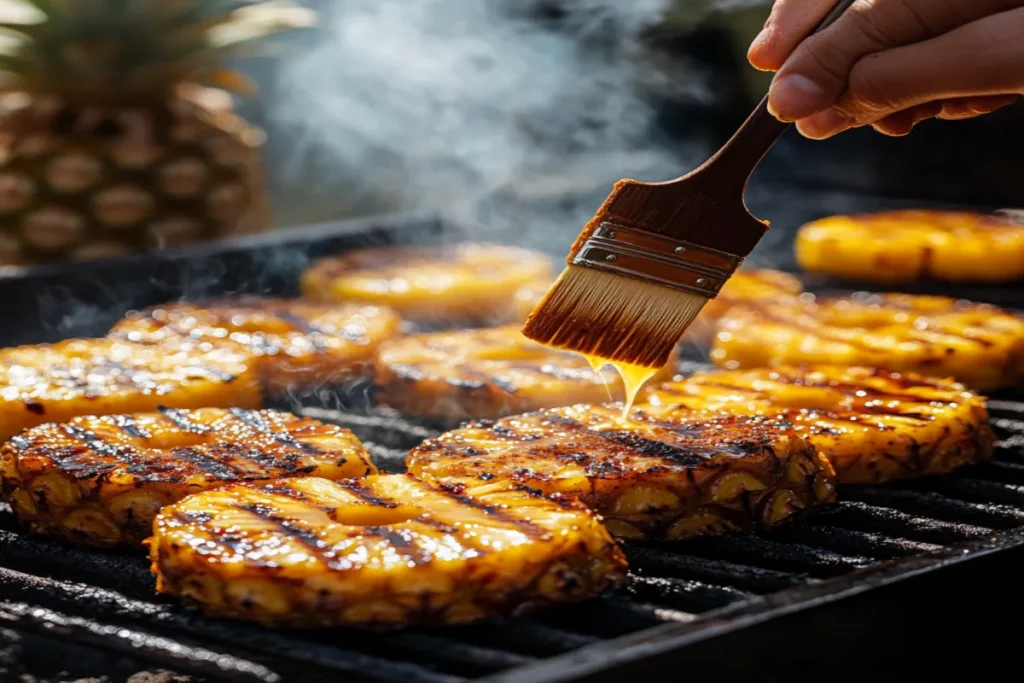
Achieving grilled pineapple perfection requires balancing caramelization with the fruit’s natural juiciness—a delicate equilibrium that elevates this dessert from good to memorable.
The most common pitfall is overcooking, which results in mushy texture and diminished flavor. To maintain the pineapple’s structural integrity and juiciness, keep cooking times brief and heat moderate to medium-high. Watch for visual cues: optimal doneness is indicated by caramelized grill marks while the fruit still holds its shape when lifted with tongs. Remember that residual heat continues cooking the fruit even after removal from the grill, so consider removing the pineapple slightly before it appears fully done.
Temperature management creates superior results. Allow refrigerated pineapple to reach room temperature before grilling, which promotes even cooking. Similarly, glazed pineapple should never go straight from refrigerator to grill—the extreme temperature differential causes uneven cooking and potential burning of the sugar in the glaze.
For flavor enhancements that elevate this dessert from excellent to extraordinary, consider these variations: Before grilling, sprinkle the glazed pineapple with a pinch of chili powder or cayenne pepper for a sophisticated sweet-heat counterpoint. Alternatively, add 1-2 tablespoons of dark rum to the glaze during the final minute of simmering for subtle complexity and depth. Fresh herbs can add aromatic intrigue—try adding finely minced rosemary to the glaze (approximately ½ teaspoon) or garnishing with fresh mint chiffonade just before serving.
Presentation transforms this simple dessert into a showstopper. For casual gatherings, serve pineapple spears in a wooden bowl with ice cream on the side. For elegant dinner parties, arrange pineapple rounds in a shingled pattern on a rectangular platter, drizzle with additional glaze, and finish with a light dusting of powdered sugar applied through a fine-mesh sieve. Consider serving individual portions on warmed plates, which helps maintain the ideal temperature contrast when served with cold accompaniments.
If using a grill pan indoors rather than an outdoor grill, ensure proper ventilation and preheat the pan for at least five minutes to achieve comparable caramelization. Apply light pressure with a spatula during the first minute of cooking to ensure good contact with the grill surface, resulting in more defined grill marks.
Variations to Explore
While the classic cinnamon sugar glaze creates a magnificent grilled pineapple experience, exploring alternative flavor profiles can keep this dessert fresh and exciting through countless iterations.
For a tropical variation, prepare a honey-lime glaze by combining ¼ cup honey, 2 tablespoons fresh lime juice, 1 teaspoon lime zest, and a pinch of salt. This brighter, tangier glaze highlights the pineapple’s natural acidity while adding complementary citrus notes. The honey caramelizes beautifully on the grill, creating a different but equally appealing finish.
Those appreciating more complex flavor profiles might enjoy a maple-bourbon glaze combining ¼ cup pure maple syrup (preferably dark grade for robust flavor), 2 tablespoons bourbon, 1 tablespoon butter, and ¼ teaspoon vanilla extract. Simmer these ingredients together until slightly reduced and syrupy. The maple contributes earthy sweetness while the bourbon adds sophisticated depth with vanilla and caramel undertones.
For adventurous palates, a coconut-ginger glaze offers intriguing complexity. Combine ¼ cup coconut milk, 3 tablespoons brown sugar, 1 teaspoon freshly grated ginger, and a small pinch of cardamom. Simmer until thickened slightly. This variation complements the pineapple’s tropical character while introducing warming spices that contrast beautifully with the fruit’s brightness.
Expand your grilled fruit repertoire by creating mixed fruit skewers. Pineapple pairs magnificently with other grillable fruits—try alternating with peach quarters, firm banana chunks (slightly underripe works best), watermelon cubes, or halved fresh figs. Each fruit brings its own sugar content and caramelization potential, creating an exploration of textures and flavors on a single skewer.
For those with dietary restrictions, several adaptations maintain the dessert’s appeal. Replace butter with coconut oil for a dairy-free version that adds subtle tropical notes. Substitute coconut sugar for brown sugar to create a less refined option with a lower glycemic index. For those monitoring carbohydrates, a glaze using a brown sugar substitute and a touch of molasses can provide similar flavor with reduced sugar content.
An elegant variation particularly suited to dinner parties involves halving and seeding fresh vanilla beans, then grilling pineapple directly on the pods. The heat releases the vanilla oils, which infuse the fruit with gentle fragrance. This technique works beautifully with any of the glaze variations, adding sophisticated aromatic complexity with minimal additional effort.
Frequently Asked Questions
Can I use canned pineapple instead of fresh?
While fresh pineapple delivers superior results, canned pineapple can work when fresh isn’t available. Select pineapple rings or chunks packed in juice rather than syrup, and drain thoroughly before using. Pat the pieces completely dry with paper towels to remove excess moisture, which otherwise prevents proper caramelization. Canned pineapple has already undergone heat processing, making it softer than fresh, so reduce grilling time by approximately half to prevent mushiness. The flavor will be less complex than fresh pineapple, but the caramelization process still creates a delicious result. Consider adding a teaspoon of fresh lemon juice to the glaze to help brighten the flavor profile when using canned fruit.
What’s the best way to store leftovers?
Allow any leftover grilled pineapple to cool completely before storing. Place in an airtight container and refrigerate for up to three days. The caramelized exterior will soften during storage as the sugars absorb moisture, but the flavor remains excellent. Store any remaining glaze separately in a small container or jar. For best results when serving leftovers, bring the pineapple to room temperature rather than serving cold from the refrigerator, which mutes the flavor complexity. Alternatively, warm gently in a 300°F oven for 5-7 minutes just until heated through, then drizzle with rewarmed glaze. While the texture won’t match freshly grilled pineapple, leftover pieces make excellent additions to breakfast yogurt parfaits or chopped into tropical fruit salads.
Can I prepare this dessert ahead of time for a party?
This dessert works beautifully with advance preparation, making entertaining more manageable. You can peel and cut the pineapple up to two days ahead, storing it in an airtight container in the refrigerator. The glaze can be prepared up to five days in advance and refrigerated, then gently rewarmed before using. For partially prepared pineapple that needs minimal attention during your gathering, pre-grill the fruit for just 1-2 minutes per side to establish grill marks, then refrigerate. Finish the grilling process for 2-3 minutes per side just before serving. This approach delivers nearly all the benefits of fresh-grilled pineapple with significantly reduced last-minute effort. For ultimate convenience, fully grill the pineapple up to 4 hours before serving and keep at room temperature, then warm briefly before serving and add fresh glaze.
Is there a way to make this dessert without a grill?
Absolutely! While outdoor grilling delivers optimal smoky flavor, several alternative methods produce excellent results. A grill pan on the stovetop over medium-high heat creates authentic grill marks and caramelization—heat the pan until very hot before adding the glazed pineapple, and ensure good ventilation. Alternatively, broiling offers similar caramelization: place glazed pineapple on a foil-lined baking sheet approximately 4 inches from the broiler element, watching carefully and turning when caramelization appears (typically 2-3 minutes per side). For completely different but equally delicious results, sear the glazed pineapple in a heavy skillet over medium-high heat, which creates a wonderful all-over caramelization rather than distinct grill marks. Each method produces slightly different results but maintains the essential character of this beloved dessert.
Conclusion
Grilled pineapple with cinnamon sugar glaze represents the perfect intersection of simplicity and sophistication—a dessert that delivers remarkable flavor with minimal effort. By harnessing the transformative power of heat against natural sugars and complementing it with warm, aromatic spices, you create a dessert experience that feels simultaneously familiar and exotic.
What makes this preparation so remarkable is its accessibility. With just a handful of everyday ingredients and basic grilling techniques, even novice cooks can create a dessert worthy of the finest restaurants. The process forgives minor imperfections while still delivering consistently delicious results, making it an ideal recipe for both weeknight treats and special occasion finales.
The versatility of this dessert extends beyond the variations we’ve explored. Consider it a template for your own culinary creativity—experiment with different spices, glazes, and accompaniments to create a signature version that reflects your personal taste. Perhaps a cardamom-infused glaze will become your specialty, or maybe you’ll discover the perfect fruit combination for mixed grilled skewers.
I’d love to hear how your grilled pineapple adventures unfold! Have you tried any of the variations mentioned? Created your own unique twist? Share your experience in the comments section below—your discoveries might inspire other readers to expand their own culinary horizons. Don’t forget to include your favorite serving suggestions or any tips you’ve discovered through your own experimentation.
For more seasonal recipes that balance indulgence with wholesome ingredients, subscribe to our newsletter. Each week, we deliver fresh inspiration directly to your inbox—from summer grilling favorites to cozy winter comfort foods, all designed to help you maximize flavor while minimizing effort. Join our community of food enthusiasts committed to exploring the extraordinary potential of simple ingredients transformed through thoughtful technique.
Happy grilling!

